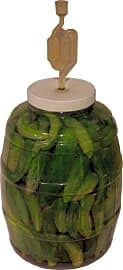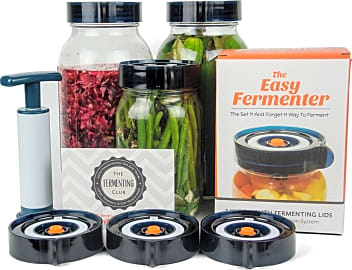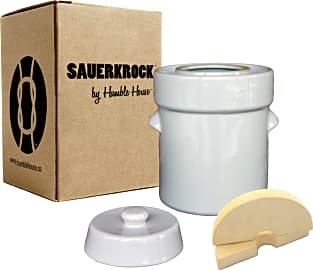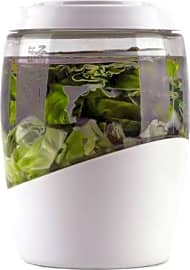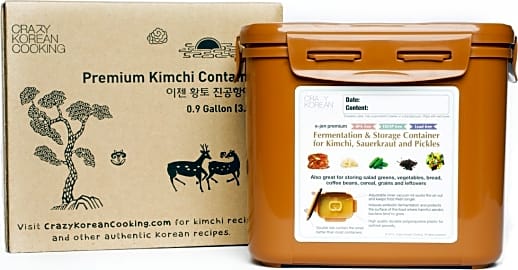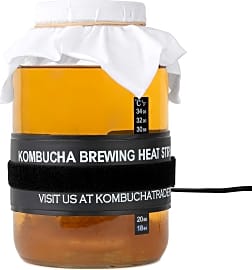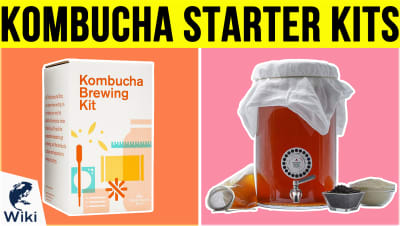The 10 Best Fermenting Kits

This wiki has been updated 39 times since it was first published in October of 2015. Fermentation is one of the oldest and healthiest methods of preserving food. If you've ever fancied trying your hand at pickling vegetables so they're available all year round, then you may want to check out one of these kits. They'll let you enjoy healthy foods at any time of year, including traditional gherkins, sauerkraut, kimchi and, in some cases, fermented beverages like wine and kombucha. When users buy our independently chosen editorial selections, we may earn commissions to help fund the Wiki.
Editor's Notes
February 24, 2020:
Fermenting vegetables is easy, inexpensive, tasty, and quite healthy, too, due to the various helpful nutrients in the resulting pickles. A majority of the options on our list are used from preparing vegetables, though there are a couple designed for fermenting beverages. The Master Vintner Small Batch is a complete winemaking kit that comes at a reasonable price, while the KichenTools Kombucha Starter is one of the most complete sets designed for making the popular fermented tea.
If you're trying to build experience and learn new pickling recipes, you might like the kits that work with standard Mason jars. The QRP Occupare Vita is especially easy to use thanks to the vented and serrated insert cups that take the place of the heavy glass weights used by many others. The Jillmo Wide Mouth is one of the most cost-effective that we found, especially if you go with the plastic version, although the material isn't quite as sturdy as that of most others. If you're okay with plastic but want something a little more solid, the Nourished Essentials Easy Fermenter is a worthwhile choice that includes a hand pump, which is something you'll need if you want to continue the process properly after having a taste test before the food is ready. The Soligt 20 is very similar, but made of metal much like standard Mason jar lids.
If you're not a stranger to fermenting your own veggies, or you need to make large batches at once, you might want a more bulk-oriented model. The Picklemeister Jar is a versatile option that comes in many sizes and is also suitable for making drinks, while the Mortier Pilon Crock and Humble House Sauercrock are both similarly sized on the outside though they don't hold as much inside. We also like the widely varied versions of the Crazy Korean E-Jen, although, unlike most others, it does require daily maintenance.
Special Honors
Alchema Home Fermenting Machine This is an interesting machine that automates a large portion of the home brewing process including measurement and sterilization, making it easy for beginners to get started making beer, wine, hard cider, sake and more. It's considerably more expensive than simple fermentation kits, and not designed for making fermented foods, but it is basically a one-of-a-kind product that makes brewing easy. alchema.com
Intentional Fermentation Is Preferable
A jar containing about eight full pickles will easily cost you more than twice what the cucumbers and brine ingredients would run you combined.
At some point in the life of anyone who regularly eats and stores food, they’ve unintentionally taken part in the process of fermentation. Maybe you’ve left a half-eaten yogurt in the back of the fridge for one too many months. Perhaps it was a smoothie you made and left on the counter, in the sun, for a week. Whatever the food source or length of time, any incidence in which some kind of microorganism goes to town on your food is a case for fermentation. Don’t mistake this for simple mold, however. The two often coexist for a time, but fermenting microorganisms do their best work in oxygen-deprived environments.
In one epic example, my dozen housemates and I threw a massive thanksgiving feast at the large house we shared in college. We fed about 35 people and partied on into the night. The next morning, much of the leftover food lie dormant on the table, probably not quite safe to eat, but not a full-fledged science experiment either. I left to catch an early flight home for the holidays, and a few of my friends told me they’d take care of the table (I’d cooked most of the food, so it wasn’t on me to clean up).
By “take care of,” apparently my friends meant that they would embark on one of the most impressive fermentation experiments I have ever seen. They quite simply left everything on the table in place, and wrapped the entirety of it in shrink wrap. The job was impressive; the barrier was practically airtight. A week later, we returned to find a table free of any interference from insects or other vermin (which, presumably, was their intent). Beneath the sealed wrapping, however, had grown species so advanced they were likely on the cusp of developing their own written language by the time we carried the entire table out to the dumpster and slid its contents — flatware and all — into the trash.
The above are examples of fermentation by human error. The fermentation kits on our list, by contrast, take advantage of much more specific forms of the interaction between certain foods and certain microorganisms. In these instances, you can create foods that you typically don’t think of as having gone bad, but that technically have succumbed to the attack of tiny creatures. Fortunately for our purposes, these creatures have a tendency to improve the foods we place in their path.
All of your favorite alcoholic beverages, for example, are brought to you by fermentation. If you like the taste of anything that’s been pickled, from cucumbers and dilly beans to eggs and pig’s feet, you can thank fermentation. A list of intentionally fermented foods could go on for quite a while, but one thing that most of them have in common is how inexpensive their base ingredients are. For the most part, when you buy a fermented product, you’re paying for the time that the process takes.
As such, when you purchase a fermenting kit of your own, you give yourself the opportunity to save a tremendous amount of money on a lot of your favorite foods. Kosher dill pickles are probably one of the most recognizable fermented foods on the market, so we’ll use those as an example. A jar containing about eight full pickles will easily cost you more than twice what the cucumbers and brine ingredients would run you combined. That can save you a ton of money. You can also reuse brine from previous batches when you make more pickles, so the more you ferment, the more you save.
The other special thing about fermenting your own products is that you can create your own unique flavors. Specialty items like these often suffer massively inflated costs, when adding a few pieces of ginger to your brine will only cost you a few extra pennies.
How To Choose The Best Fermenting Kit For You
There are fermenting kits out there that are designed to let you create a large amount of different foods. Choosing the right one for you will have a lot to do with how much food you want to ferment in a given session, and exactly what it is you want to make.
There are fermenting kits out there that are designed to let you create a large amount of different foods.
Most kits allow you to place foods in jars, load them up with included fermenting ingredients, add any extra flavorings specific to your palette, and wait until nature takes its course. These kits are usually used for pickling items like vegetables, eggs, and other simple foods.
If you want to be able to make large batches, but variety isn’t as important to you, look for a kit with fewer jars that can contain more food. You’ll have less work ahead of you in preparation and cleanup, and you won’t have to worry about labeling anything.
On the other hand, if you want to create many different flavors of the same pickled item, you’ll want a kit with more, smaller jars. Additionally, so you don’t get confused, it might be a good idea to invest in a high-quality label maker to keep your jars organized.
A Brief History Of Fermentation
Fermentation has gone on since long before there were human beings to enjoy the pleasantly rotted fruits of the process. That’s because microorganisms far predate the arrival of mankind on the scene.
Some monkey's have been shown to bury ripe fruit underground, and return to it later, after natural fermentation.
When humans finally got around to eating fermented foods, it wasn’t the result of culinary experimentation, but rather of survival. The choice was simple: eat the food that looked spoiled or starve. Luckily for whoever took the chance, the fermented food was pretty good.
The intentional kind of fermentation — which we’ve established as far preferable — dates back at least to 7000 B.C.E. in Jiahu, China. That's true for humans, anyway. Some monkey's have been shown to bury ripe fruit underground, and return to it later, after natural fermentation. They intentionally get drunk off what is essentially the equivalent of prison hooch.
In the mid-1850s, Louis Pasteur piggybacked on the recent discovery of yeast’s reproduction processes. He showed through a series of experiments how yeast played a pivotal role in a number of fermentations. One such experiment resulted in the death of all the microorganisms in his sample, and led to the process we now call Pasteurization.


